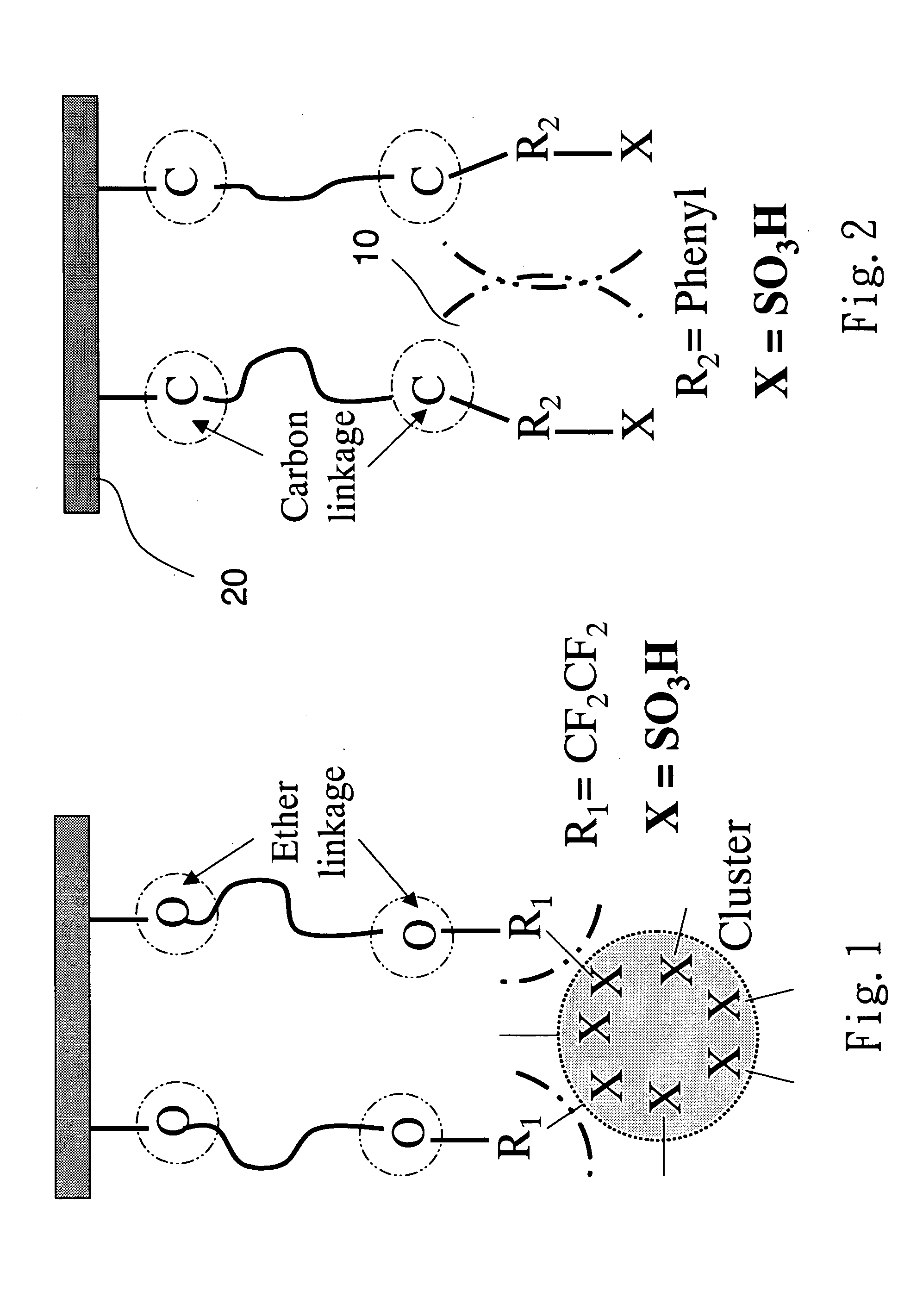Structures of the proton exchange membranes with different molecular permeabilities
a proton exchange membrane and molecular permeability technology, applied in the direction of water management in fuel cells, conductive materials, chemical/physical processes, etc., can solve the problems of increasing the swelling of materials at the same time, and achieve the effect of reducing the fuel permeation of methanol molecules, preventing the decrease of cell efficiency, and increasing the volume energy density of the entire cell
- Summary
- Abstract
- Description
- Claims
- Application Information
AI Technical Summary
Benefits of technology
Problems solved by technology
Method used
Image
Examples
embodiment 1
[0036] 1. 40 grams of styrene monomer (purity 99.9%) is added to 40 grams of polyvinylidene difluoroethylene resins. Uniform stirring gives a mixture (PVDF-g-PS). Then the grafting reaction is performed by Co-60 irradiation with the control of the radiation dosage at 25 kGy.
[0037] 2. The crude products of polyvinylidene difluoroethylene grafted polystyrene resin (PVDF-g-PS) are treated with ethyl acetate for Soxhlet extraction to remove the un-reacted monomers and styrene homo-polymers. The products are dried under ambient temperature or by heating to obtain white PVDF-g-PS products. The grafting percentage is 62.5 wt %.
[0038] 3. Add 6.9 g of PVDF-g-PS and 10 mg of fluorosurfactant FC-430 and dissolve in 70 ml of 1-Methyl-2-pyrrolidone. Then the membrane is formed under 120° C.
[0039] 4. Then the membrane undergoes the sulfonation reaction at 25° C. with chlorosulfonic acid for 8 hours of reaction time. The membrane after sulfonation is washed with tetrahydrofuran and water, then ...
embodiment 2
[0040] 1. 40 grams of styrene monomer (purity 99.9%) is added to 40 grams of polyvinylidene difluoroethylene resins. Uniform stirring gives a mixture (PVDF-g-PS). Then the grafting reaction is performed by Co-60 irradiation with the control of the radiation dosage at 25 kGy.
[0041] 2. The crude products are treated with ethyl acetate for Soxhlet extraction to remove the un-reacted monomers and styrene homo-polymers. The products are dried under ambient temperature or by heating to obtain white PVDF-g-PS products. The grafting percentage is 62.5 wt %.
[0042] 3. Add 9 g of PVDF-g-PS, 12.5 g of polyvinylidene difluoroethylene resin and 30 mg of fluorosurfactant FC-430 and dissolve in 210 ml of 1-Methyl-2-pyrrolidone. Then the membrane is formed under 120° C.
[0043] 4. Then the membrane undergoes the sulfonation reaction at 25° C. with chlorosulfonic acid for 8 hours of reaction time. The membrane after sulfonation is washed with tetrahydrofuran and water, then dried at 80° C. under vac...
embodiment 3
[0044] 1. 50 grams of styrene monomer (purity 99.9%) is added to 40 grams of polyvinylidene difluoroethylene resins. Uniform stirring gives a mixture (PVDF-g-PS). Then the grafting reaction is performed by Co-60 irradiation with the control of the radiation dosage at 25 kGy.
[0045] 2. The crude products of PVDF-g-PS are treated with ethyl acetate for Soxhiet extraction to remove the un-reacted monomers and styrene homo-polymers. The products are dried under ambient temperature or by heating to obtain white PVDF-g-PS products.
[0046] The grafting percentage is 71 wt %.
[0047] 3. Add 5 g of PVDF-g-PS, 10 g of polyvinylidene difluoroethylene resin, 0.5 g acrylate elastomer, 0.2 g of dioctylphthalate and 20 mg of fluorosurfactant FC-430 and dissolve in 160 ml of 1-Methyl-2-pyrrolidone. Then the membrane is formed under 120° C.
[0048] 4. Then the membrane undergoes the sulfonation reaction at 25° C. with chlorosulfonic acid for 8 hours of reaction time. The membrane after sulfonation is ...
PUM
| Property | Measurement | Unit |
|---|---|---|
| Electrical conductivity | aaaaa | aaaaa |
| Kinematic viscosity | aaaaa | aaaaa |
| Concentration | aaaaa | aaaaa |
Abstract
Description
Claims
Application Information
 Login to View More
Login to View More - R&D
- Intellectual Property
- Life Sciences
- Materials
- Tech Scout
- Unparalleled Data Quality
- Higher Quality Content
- 60% Fewer Hallucinations
Browse by: Latest US Patents, China's latest patents, Technical Efficacy Thesaurus, Application Domain, Technology Topic, Popular Technical Reports.
© 2025 PatSnap. All rights reserved.Legal|Privacy policy|Modern Slavery Act Transparency Statement|Sitemap|About US| Contact US: help@patsnap.com



